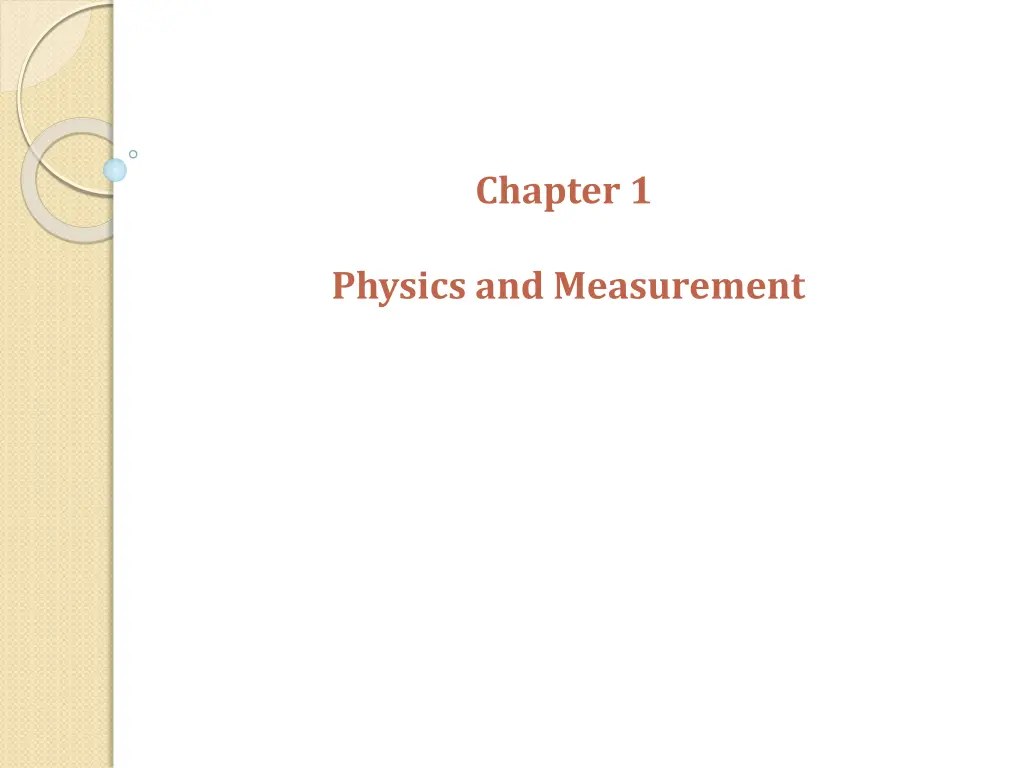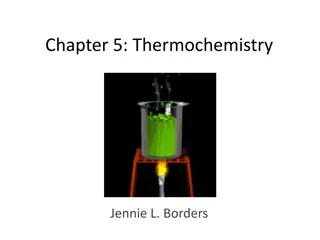
Physics and Measurement Essentials
Explore the fundamental concepts of physics such as standards of measurement, density, atomic mass, and dimensional analysis. Learn about the importance of units and prefixes in scientific calculations through practical examples and explanations.
Download Presentation

Please find below an Image/Link to download the presentation.
The content on the website is provided AS IS for your information and personal use only. It may not be sold, licensed, or shared on other websites without obtaining consent from the author. If you encounter any issues during the download, it is possible that the publisher has removed the file from their server.
You are allowed to download the files provided on this website for personal or commercial use, subject to the condition that they are used lawfully. All files are the property of their respective owners.
The content on the website is provided AS IS for your information and personal use only. It may not be sold, licensed, or shared on other websites without obtaining consent from the author.
E N D
Presentation Transcript
Chapter 1 Physics and Measurement
LECTURE OUTLINE 1.1 Standards of Length, Mass, and Time 1.3 Density and Atomic Mass 1.4 Dimensional Analysis 1.5 Conversion of Units 2
1.1 Standards of Length, Mass, and Time In mechanics, there are three basic quantities: length, mass, and time All other quantities in mechanics can be expressed in terms of these three. In1960, an international committee established a set of standards for the fundamental quantities of science. It is called the SI (Syst me International) In the SI: Units of length: meter (m) Units of mass : kilogram (Kg) Units of time : second (s) 3
In many situations, you may have to derive or check a specific equation. A useful and powerful procedure called dimensional analysis can be used to assist in the derivation or to check your final expression. As a simple method: Left Hand Side must = Right Hand Side
Some Prefixes for Powers Used with Metric (SI and cgs) Units Power Prefix Abbreviation 1018 1015 1012 Exa Peta E P Tera or Viga T or V 109 106 103 101 Giga Mega Kilo Deca xxxxxxxx G M K D 100 =1 10-1 10-2 10-3 10-6 10-9 10-12 10-15 10-18 deci centi milli micro nano pico femto atto d c m n p f a
1.3 Density and Atomic Mass The density of a substance is defined as its mass per unit volume: = m/V Different substances have different densities mainly because of differences in their atomic masses and atomic arrangements. The numbers of protons and neutrons in the nucleus of an atom of an element are related to the atomic mass of the element, which is defined as the mass of a single atom of the element measured in atomic mass units (u) where: 1 u = 1.660 538 7 10 -27 kg. 6
As an Example: the atomic mass of lead is 207 u and that of aluminum is 27.0 u. Example 1.1: A solid cube of aluminum (density 2.70 g/cm3) has a volume of 0.200 cm3. It is known that 27.0 g of aluminum contains 6.02 1023 atoms. How many aluminum atoms are contained in the cube? Solution: Because density equals mass per unit volume, the mass of the cube is: m = V = (2.70 g/cm3)(0.200 cm3) = 0.540 g ,? =? ?? 1.20 1022????? ??=0.540 6.02 1023 = 27.0
1.4 Dimensional Analysis Dimension: it denotes the physical nature of a quantity Example: distance: could be in meters, yards, or micrometers. But over all it is: a length. In 1960, an international committee agreed on a standard system of units for the fundamental quantities of science, called SI (Syst me International). Its units of length (meter), mass (kilogram) and time are the meter (second):(mks units). Symbols we are going to use are: dimension of length: [L] dimension of mass: [M] dimension of time: [T] 8
Quantity Abbreviation Unit , x, d, r, h m Length or Distance m t Kg S Mass time F= mg C Newton Farad kg m/s2 Force Capacitance Q, q T Coulomb oC, K, oF Charge Temperature Joule kg m2/s2 K (KE), U (PE) Energy
1.4 Dimensional Analysis Example: Use dimensional analysis to check the equation: ? =1 2??2 Solution: ? ?2.?2= ? ? = Example: Show that ? = ?? is dimensionally correct. Solution: L.H.S.: ? = ? ??? ?.?.? ?? = ? ? ? ? ?2.? = L.H.S=R.H.S So the equation is dimensionally correct 11
Example 1.3: Suppose we are told that the acceleration a of a particle moving with uniform speed v in a circle of radius r is proportional to some power of r, say rn, and some power of v, say vm. Determine the values of n and m and write the simplest form of an equation for the acceleration. Solution: Let us take a to be: a = k rn vm where k is a dimensionless constant of proportionality. Knowing the dimensions of a, r, and v, we see that the dimensional equation must be:
PROBLEMS (H.W) Section 1.4 Dimensional Analysis 13. The position of a particle moving under uniform acceleration is some function of time and the acceleration. Suppose we write this position ? = ????? where k is a dimensionless constant. Show by dimensional analysis that this expression is satisfied if m = 1 and n = 2. Can this analysis give the value of k? 13
PROBLEMS Section 1.4 Dimensional Analysis 15. The position of a particle moving under uniform Which of the following equations are dimensionally correct? a) ??= ??+ ?? b) ? = 2? cos ?? ,? ??? ? = 2? 1 14
1.5 Conversion of Units Other Unit System U.S. customary system: foot, slug, second Cgs system: cm, gram, second We will use SI units in this course, but it is useful to know conversions between systems. 1 mile = 1609 m = 1.609 km 1 ft = 0.3048 m = 30.48 cm 1 m = 39.37 in. = 3.281 ft 1 in. = 0.0254 m = 2.54 cm 1 lb = 0.465 kg 1 oz = 28.35 g 1 day = 24 hours = 24 * 60 minutes = 24 * 60 * 60 seconds 1 slug = 14.59 kg More can be found in Appendices A & D in your textbook. 15
PROBLEMS Section 1.5 Conversion of Units 21. A rectangular building lot is 100 ft by 150 ft. Determine the area of this lot in m2. 25. A solid piece of lead has a mass of 23.94 g and a volume of 2.10 cm3. From these data, calculate the density of lead in SI units (kg/m3). 31. One gallon of paint (volume=3.78 10-3 m3) covers an area of 25.0 m2. What is the thickness of the paint on the wall? 16






















